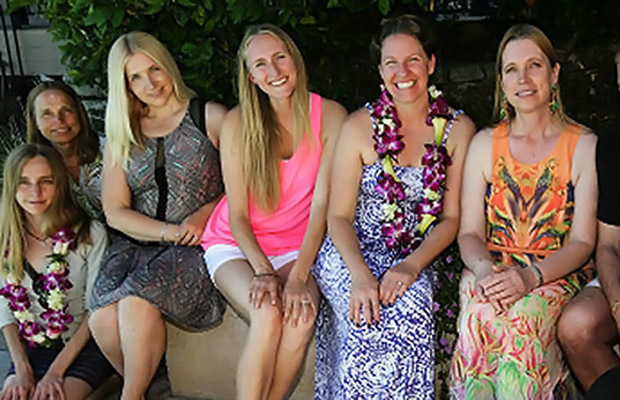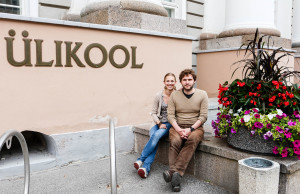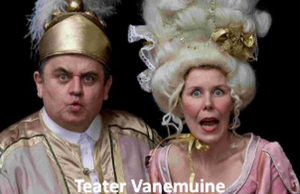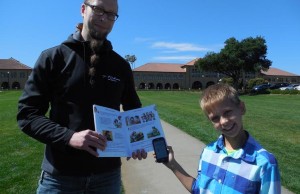Estonian Society is run by hardworking Estonian women

“I got your contacts from Ingrid…” or “I’m sure you know Ingrid…” is a typical opening for Estonians who have just recently moved to the the Bay Area or if they are being introduced to a person who has been living in this area for a while.
This wonderful person whom everybody seems to know so well and who is introducing the “newbies” to the “oldies” and selflessly helps everyone, is Ingrid Arulaid Echter who served as President of San Francisco Estonian Society for the past three years.
I also got to know Ingrid because I needed her help. I was organizing an event introducing Estonia to the Sloan class of 2013 at Stanford Business School and someone gave me Ingrid’s contacts. Although she was in her last weeks of pregnancy at the time while organizing a party for Estonian Independence Day she was willing to help me out as well. A month later we met at the Independence Day event, she ran up to me to introduce me to another friend of her’s. She was doing everything at once, with a few weeks old Ellie Katherine on her tow. While some new moms find it very hard to keep up with their social lives, Ingrid seems to juggle everything so smoothly as if there were more than 24 hours in a day.
Thanks to Ingrid’s tireless energy a big joint event of LEP-ESTO took place in San Francisco this summer that attracted more than a thousand people from near and far. Ingrid now admits that pulling together the internationally known ESTO-days and the West Coast Estonian Days was a wonderful experience that taught her managing processes, team building, including and making people feel special… and was really tiresome too.
Firestarter
Ingrid is actually quite a newbie in the Bay Area herself. She moved here only 4 years ago from the East Coast where she had previously lived for 10 years because of her husband Adam’s job.
She came to the US when she was only 18 to work as a babysitter in New York. She visited the local Estonian House there but at some point felt that she had had enough of fellow Estonians. For years she kept away.
“When I moved to the Bay Area, I realized that I really miss the company of other Estonians. And when I became active in the local Estonian community I became a true patriot,” explains Ingrid. She now understands that nothing in the world can add up to the fact that fellow Estonians, no matter where they live in the world, just understand each other as they share the same cultural background.
Ingrid got aqcuainted to local Estonians by mere coincidence: she moved to the same apartment complex where Silver Stoltsen, a long-time president of Estonian Society, lived. He saw great potential in Ingrid to keep up what he had built over the previous years.
Silver who has lived in theBay Area for 17 years and is active in internet marketing is being modest about his contribution: “The best thing I did in those 6 years was finding Ingrid.” This is actually not quite true as he kept alive the celebrations of the Independence Day as well as starting a whole new series of events: the annual Baltic Picnic. He got the idea while studying Business at San Francisco State University where he had a class assignment to implement a project that seemed impossible pull off to start with. Silver got several hundred Estonians, Latvians and Lithuanians together to compete in sports games and enjoy their national dishes. Next year the annual picnic will be held for 10th time.
Engineer of human souls
“Silver told me that you don’t have to do much more than organize two events in a year: the Independence Day and the Baltic Picnic,” Ingrid recalls. For decades these two events had been the pillars of the social scene of Estonian Society, founded here in the Bay Area already back in 1950s.
But she, of course, would not settle for just those two events. To get to know the other local Estonians better and make them work for the same goals, she organized a voluntary clean-up event at San Francisco Zoo. Much more people showed up than expected and everyone from small babies to the elderly loved it. As people asked for more, she came up with another event: unweeding the flower-beds on the island of Alcatraz. And yet to come was the making of the blood sausages giving the younger people a possibility to learn from more experienced friends how to make traditional Estonian Christmas food.
“It was my goal to unite the different generations and social groups,” Ingrid is explaining her strategy in leading people. She has studied Business Management in university and worked as a massage therapist but has a natural talent in reading people’s minds. “I really wanted to meet every Estonian who moved to the neighbourhood personally so that everybody would feel as part of the group. Whenever I spoke to a friend, I asked: “Tell me who are the other Estonians in the Bay Area!” and if I had not yet met some of them, I asked them to introduce me.”
Time for a break
This technique worked wonders. “When I started, we had about 60-80 active participants, now we have about 170,” Ingrid implies to the popularity of events. There is a lot of “fresh blood” both amongst the local Estonians as well as the people active in the Estonian Society. “My mission was to give those events a head start and then step aside,” she concludes her work.
Ingrid did all of those things just out of her patriotism and sense of duty. It’s not very common for an Estonian to pat someone on the back for a job well done or shower others in compliments. After finishing the ESTO-days that did bring her praise but also bitter critisism, she felt she does not have much more to give and should concentrate more on herself and her family.
“Ellie is the biggest hobby in my life,” she declares when I ask her if she would have more time to spend on her hobbies from now on. “I knew since I was 3 or 4 that I want to become a mother. And now it’s about time to fully enjoy it!”
She stepped down as a president of Estonian Society in October but is still very much active and present in every event and willing to share contacts. The much needed break from work turned out to be a short one and since the beginning of this year Ingrid serves as an executive director at Silicon Vikings, a non-profit member organization for networking and promotion of technologies and businesses intersecting Silicon Valley and the Nordic region – Denmark, Estonia, Finland, Iceland, Norway, and Sweden.
A fresh breeze
But the Estonian Society is most certainly not going to unwind.
For a while Ingrid has been supported by Mai-Liis Barling who now became the new president. She will keep up the same direction but also set a new standard with her composed and balanced subtlety.
“It’s like builing a house, get certain pieces in place,” Mai-Liis draws a parallel to starting the Estonian language learning group and the kids school.
“I grew up in Los Angeles and we had a lot of Estonian activities there,” she explains why she wanted to join in the Estonian activities instead of enjoying a well-deserved peaceful retirement. She also felt a sense of moral obligation to keep up the good work of those people who had been running the San Francisco Estonian Society since moving here after the Second World War. Having heard some complaints in the cirles of the so-called “second generation Estonians” that some people felt very insecure about their skills in Estonian she and some of her friends decided to start a language learning group. To their great surprise more than 15 people showed up in the first class and the enthusiasm has not unwinded ever since.
As they also started organizing the West Coast Estonian Days at the same time, they decided to start publishing a newsletter too. The monthly newsletter is being sent to 275 people via e-mail and also delivered to 60 people on paper.
To follow up the language leraning group and the newsletter they also started an Estonian school for kids that meets once a fortnight in San Mateo and in Berkeley. “When the kids start speaking English to each other the parents realize it’s time to make an effort to keep up with their Estonian heritage,” Mai-Liis knows the growing interest in the kids school.
Faraway-land
Mai-Liis herself speaks flawless Estonian despite the fact she never lived in Estonia. She was born in 1953 in Germany where her parents had met each other in a refugee camp in Augsburg. Being a war refugee in a foreign country was not pleasant so her mother decided to move to the US, Los Angeles, in 1956 with her two daughters. As her father had tuberculosis he could not join his family and stayed in Bonn representing Estonia as a consul in exile. For the rest of the world Estonia had become a part of the big red Soviet Union that had swallowed up 1/6 of the land on Earth.
“We did now know what would become of Estonia or if we will ever get there,” she recalls memories from her childhood. But she did manage go to Estonia for the first time in 1974 with her sister. “We were really anxious to go there. It was so amazing to finally see the country I had heard so much about and meet our family for the very first time. But we also saw that life had been much harder for them.” She has been to Estonia many times since and is glad to see the life improving continuously.
“Estonian reputation in the US is so much better today,” she’s proud to say. Everybody who asks her about Estonia already knows the story of this tiny but courageous country that broke free from the Soviet Union by a Singing Revolution and the story of e-Estonia is also relatively well-known.
Working hard
Mai-Liis is taking after her mother Aino who set an example of working hard to be independent and successful in life. Aino is 98 and now lives in Oregon and can still manage all of her daily routines by herself.
“LA was a great place to grow up in, there was a lot of diversity already in the 1950s,” Mai-Liis remembers. Being a shy girl it took her some courage to explain everyone the background of her special name and tell the story of the country her parents came from. But she never had to be ashamed of her Estonian roots. There was aready quite an active Estonian scene in LA at the time: Estonian House, kids and youth school, national dance groups etc.
The West Coast Estonian Days (LEP) that were every two years brough Mai-Liis to San Francisco for the first time in her life in 1959. “This was such a magical place!” she remembers thinking about her future home town as a 6-year-old girl.
While studying Urban Environment at UC Santa Barbara she met her future husband Don and they eventually settled near his home in the Bay Area. She started working at the Golden Gate National Recreational Area holding several positions there over the course of 31 years. For her final 9 years she was a Deputy Superintendent in charge of all the parks and popular tourist destinations like Alcatraz and the Muir Woods. She herself considers turning historic military posts such as Fort Baker and Presidio into recreational areas as her biggest achievement.
At 56 she felt it was time to retire and spend more time with her family. The youngest of her 3 kids was still in high school and her 93-year-old mother needed more support. Now her younger son is also a student in the same university she once graduated, he’s studying Biochemistry. Her older son has a degree in Philosophy and he works in Alcatraz with helping tourists. Her daughter Linnea received her degree in Molecular Biology and has worked in many different areas. Currently she’s helping her mother with the newsletter as a designer and she’s also actively participating in other Estonian Society’s events.
What comes next?
Mai-Liis, Ingrid and Silver all mention the phrase “Estonian House” several times while talking about Estonian Society in the Bay Area.
There is an Estonian House in Portland, New York and Los Angeles. The Canadian Estonian Societies all have their own buildings. But the Society in San Francisco still does not have one for several different reasons. Sometimes Estonians can rent the house from Latvians but it’s still quite not “it”. Although Estonia is an e-country and there is a “Virtual Estonian House” as a Facebook group people still want to meet in real life and communicate face-to-face.
“The most important thing for the Estonian Society is finding its own house,” says Silver. “This would give us a place to meet, share contacts and possibly offer housing to guests from Estonia. This would really draw us all closer together.”












